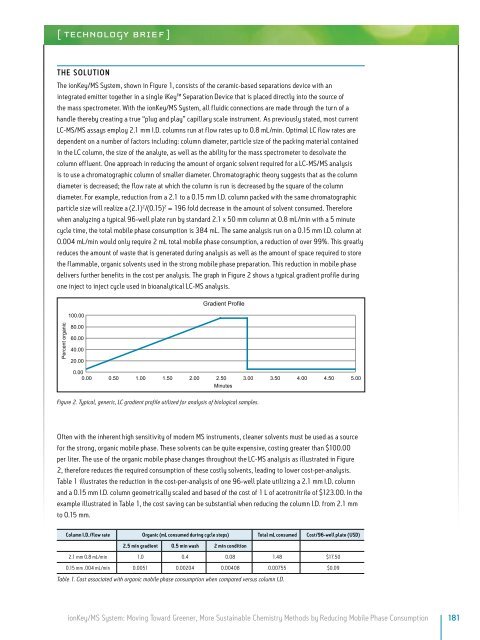ionkey/MS
1TDCbKs
1TDCbKs
Create successful ePaper yourself
Turn your PDF publications into a flip-book with our unique Google optimized e-Paper software.
THE SOLUTION<br />
The ionKey/<strong>MS</strong> System, shown in Figure 1, consists of the ceramic-based separations device with an<br />
integrated emitter together in a single iKey Separation Device that is placed directly into the source of<br />
the mass spectrometer. With the ionKey/<strong>MS</strong> System, all fluidic connections are made through the turn of a<br />
handle thereby creating a true “plug and play” capillary scale instrument. As previously stated, most current<br />
LC-<strong>MS</strong>/<strong>MS</strong> assays employ 2.1 mm I.D. columns run at flow rates up to 0.8 mL/min. Optimal LC flow rates are<br />
dependent on a number of factors including: column diameter, particle size of the packing material contained<br />
in the LC column, the size of the analyte, as well as the ability for the mass spectrometer to desolvate the<br />
column effluent. One approach in reducing the amount of organic solvent required for a LC-<strong>MS</strong>/<strong>MS</strong> analysis<br />
is to use a chromatographic column of smaller diameter. Chromatographic theory suggests that as the column<br />
diameter is decreased; the flow rate at which the column is run is decreased by the square of the column<br />
diameter. For example, reduction from a 2.1 to a 0.15 mm I.D. column packed with the same chromatographic<br />
particle size will realize a (2.1) 2 /(0.15) 2 = 196 fold decrease in the amount of solvent consumed. Therefore<br />
when analyzing a typical 96-well plate run by standard 2.1 x 50 mm column at 0.8 mL/min with a 5 minute<br />
cycle time, the total mobile phase consumption is 384 mL. The same analysis run on a 0.15 mm I.D. column at<br />
0.004 mL/min would only require 2 mL total mobile phase consumption, a reduction of over 99%. This greatly<br />
reduces the amount of waste that is generated during analysis as well as the amount of space required to store<br />
the flammable, organic solvents used in the strong mobile phase preparation. This reduction in mobile phase<br />
delivers further benefits in the cost per analysis. The graph in Figure 2 shows a typical gradient profile during<br />
one inject to inject cycle used in bioanalytical LC-<strong>MS</strong> analysis.<br />
Gradient Profile<br />
100.00<br />
Percent organic<br />
80.00<br />
60.00<br />
40.00<br />
20.00<br />
0.00<br />
0.00 0.50 1.00 1.50 2.00 2.50 3.00 3.50 4.00 4.50 5.00<br />
Minutes<br />
Figure 2. Typical, generic, LC gradient profile utilized for analysis of biological samples.<br />
Often with the inherent high sensitivity of modern <strong>MS</strong> instruments, cleaner solvents must be used as a source<br />
for the strong, organic mobile phase. These solvents can be quite expensive, costing greater than $100.00<br />
per liter. The use of the organic mobile phase changes throughout the LC-<strong>MS</strong> analysis as illustrated in Figure<br />
2, therefore reduces the required consumption of these costly solvents, leading to lower cost-per-analysis.<br />
Table 1 illustrates the reduction in the cost-per-analysis of one 96-well plate utilizing a 2.1 mm I.D. column<br />
and a 0.15 mm I.D. column geometrically scaled and based of the cost of 1 L of acetronitrile of $123.00. In the<br />
example illustrated in Table 1, the cost saving can be substantial when reducing the column I.D. from 2.1 mm<br />
to 0.15 mm.<br />
Column I.D./flow rate Organic (mL consumed during cycle steps) Total mL consumed Cost/96-well plate (USD)<br />
2.5 min gradient 0.5 min wash 2 min condition<br />
2.1 mm 0.8 mL/min 1.0 0.4 0.08 1.48 $17.50<br />
0.15 mm .004 mL/min 0.0051 0.00204 0.00408 0.00755 $0.09<br />
Table 1. Cost associated with organic mobile phase consumption when compared versus column I.D.<br />
ionKey/<strong>MS</strong> System: Moving Toward Greener, More Sustainable Chemistry Methods by Reducing Mobile Phase Consumption<br />
181


